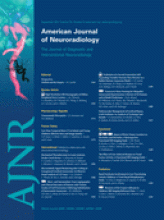Abstract
BACKGROUND AND PURPOSE: VRSs are the perivascular spaces surrounding the deep perforating arteries in the brain. Although VRS variations with age and disease pathologies have been reported previously, the radiologic characteristics of the VRS in relation to AD are poorly understood. This study investigated the prevalence, spatial distribution, and severity of the VRS in AD, MCI, and older adults who were CN. It also investigated the relationship of the VRS to white matter changes.
MATERIALS AND METHODS: Structural MR imaging data were acquired from 158 participants (AD = 37, MCI = 71, CN = 50, mean age = 74.97 ± 7.20 years) who had undergone T1WI at 3T. The severity of VRS in the white matter, basal ganglia, hippocampus, and brain stem structures was evaluated by using a semiquantitative scale, adapted from existing rating scales. A VRS total score summarizing the subscales was calculated to assess the whole-brain VRSs.
RESULTS: VRSs were observed in multiple brain regions of all participants, typically presented as <2-mm well-margined symmetric round-, oval- and linear-shaped hypointensities on T1WI. The VRS total score increased with leukoaraiosis, atrophy, and advanced age (P < .001). Individuals with AD and MCI showed greater levels of VRS than control subjects. The VRS total score discriminated individuals with AD and those who were CN with an accuracy of 0.79 (95% CI, 0.69–0.89).
CONCLUSIONS: VRSs are common in older adults and are more severe in AD and MCI than in CN. Whether increased VRSs can be reliably used to aid in AD diagnosis warrants further investigation.
Abbreviations
- AD
- Alzheimer disease
- ADNI
- Alzheimer Disease Neuroimaging Initiative
- ANOVA
- analysis of variance
- AUC
- area under the curve
- BG
- basal ganglia region
- BS
- brain stem
- CDR
- Clinical Dementia Rating
- CI
- confidence interval
- CN
- cognitively normal
- CS
- centrum semiovale
- FL
- frontal lobe
- HP
- hippocampal area
- ICC
- interclass correlation
- MCI
- mild cognitive impairment
- MMSE
- Mini-Mental State Examination
- OL
- occipital lobe
- PL
- parietal lobe
- ROC
- receiver operating characteristic curve analysis
- T1WI
- T1-weighted imaging
- T2WI
- T2-weighted imaging
- TL
- temporal lobe
- VRS
- Virchow-Robin space
- © 2011 by American Journal of Neuroradiology
Indicates open access to non-subscribers at www.ajnr.org












